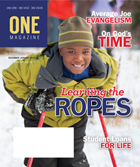
December-
January 2013
Learning the Ropes
------------------
|

intersect, where the bible meets life
The Long Line Marked, "Teachers Only"
Walt Kaiser said once that when you come to Christ’s judgment seat, and there are two lines—one shorter and the other very long—get in the shorter line because the other one is the line for teachers. It will take a while to get through that one!
No wonder James (3:1) cautions us not to jump at the chance to be a teacher. The role carries great responsibility and demands high expectations. It’s a risky role, yet the rewards are through the roof. What is a teacher like, really? Or better, who is a teacher?
-
A teacher is a clue-tracker. I mean as in a detective story—investigating clues. Teachers track down leads until they figure out the mystery or solve the puzzle. Real teachers have an insatiable thirst to know. They will turn over every rock to see what’s under it.
-
A teacher never stops learning.Teachers are like perpetual five-year-olds ceaselessly asking, “Why?” And they will investigate until they find an answer if one is possible. Teachers spend their lives researching life.
-
A teacher is a storyteller. Tell me a story, and you’ve got me hooked. We love stories because they are constructed from the DNA of real life. It’s not just that everyone has a story; everyone is a story. Life is a story. The Bible itself is an amazing narrative that unfolds with a “very good” beginning, a “bad news/good news” middle, and the most fantastic ending imaginable. It really is “the greatest story ever told.” A teacher looks for stories because they are everywhere. He can connect the dots by explaining why “this is like that,” as Jesus did in His parables.
-
A teacher is a lift-spotter. Here’s what I mean. In weightlifting, a coach or trainer is often responsible to stand close by so the lifter doesn’t drop the bar and injure himself. The same is true in gymnastics when the spotter stands under the gymnast to prevent him or her from falling.
Students aren’t perfect. While the teacher wants them to spread their wings and take off, he also knows that bumps and bruises happen. So he stands near his student, ready to break a fall or grab a falling weight. One day he’ll turn the student loose—but not yet.
-
A teacher is a hurt-healer. Sometimes a student needs a challenge, sometimes a rebuke. But he always needs to know his teacher cares. Teacher, he needs to know that you are vulnerable, too; your transparency needs to be clear to him (pun intended). Pray. Spend time. Empathize. Listen, and look your student in the eye while you listen. Though there will and should be distance between you and your student, he will not invite you into his life unless you are a friend.
-
A teacher is a risk-taker. True, you must be yourself. A teacher with a Christian worldview must not abandon that commitment. But you miss opportunities if you don’t venture out and consider the grid through which your students interpret your teaching. To some extent, you need to live in their world and see through their eyes.
Never rule out the possibilities of what may come through the process of learning. Go to bat with your student even though you may not be sure what pitch is coming next!
-
A teacher is a passion-igniter. Author David McCullough pinpointed the key to effective teaching: “Let your students see what you love.” Burn with passion, and they will feel the heat. That doesn’t necessarily mean that your passion will become theirs. But there’s a good chance they will catch fire with their passion when they sense the heat of yours. A love for learning is contagious.
-
A teacher is a witness. When we teach, it is not so much what we are doing but what our students are seeing in and through us. Annie Dillard reminds us:
We are here to witness . . . . We can stage our own act on the planet—build our own cities on its plains, dam its rivers, plant its topsoils—but our meaningful activity scarcely covers the terrain. We do not use songbirds, for instance. We do not eat many of them; we cannot befriend them; we cannot persuade them to eat more mosquitoes or plant fewer weed seeds. We can only witness them (Teaching a Stone to Talk).
So we help our students by bearing witness to what is all around us. Yet, it is also true that in a real sense we teach ourselves to our students. We are effective not because of what we teach—technique—but because of who we are—character.
As Parker Palmer says, “Technique is what teachers use until the real teacher arrives...Good teaching cannot be reduced to technique; good teaching comes from the identity and integrity of the teacher.”
On second thought, you may want to stand in that line after all. The wait may take awhile, but the benefits are fabulous.
[An abridged version of a presentation to the Welch College faculty on
August 24, 2012]
Intersect: Where the Bible Meets Life is a regular column written by Dr. Garnett Reid, a member of the Bible faculty at Welch College. Visit his blog: www.garnettreid.com.
|
|

